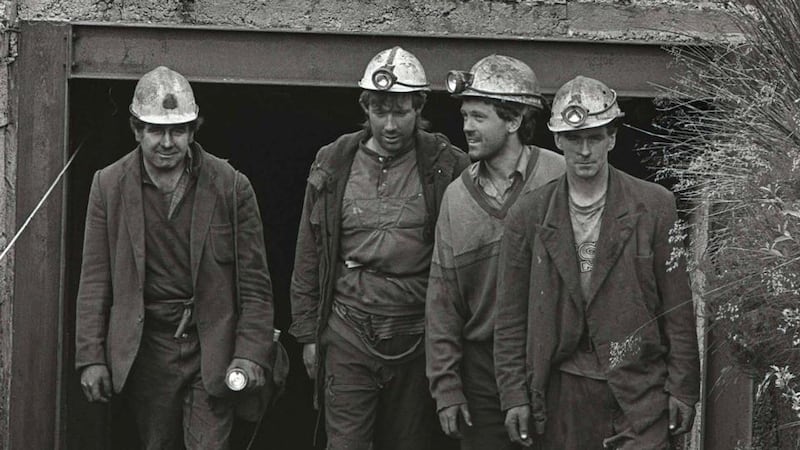Maurice Cullen remembers being in the Miner's Bar in Arigna village one summer's evening with a gang of other thirsty pit men when "a few yanks" drifted in off a tour bus.
“I think for a minute they thought they were back in Harlem,” joked the former miner, remembering the bewilderment of the visitors at the sight of so many soot black faces.
Writer Brian Leyden grew up in Arigna where coal blackened miners, the whites of their eyes shining in the dusk, were ferried home over the mountain on the back of an open topped lorry. After an eight hour shift, often spent lying in pools of water, coal dust seeped into every pore and stiffened their damp clothes.


“They were savage conditions,” said Leyden. Being asthmatic, he escaped the drudgery of the pits.
Next Thursday evening at the Dock in Carrick on Shannon, the writer will mark the 25th anniversary of the shutdown of the Arigna mines in a collaboration with local musician Colm Beggan and photographer David Knight.
Ace of spades
Seamus Leheny
was 14 when he started working in Arigna, alongside his father and five brothers. “At the end of the day you would be black as the ace of spades,” he said.
In the beginning his only protection from the low jagged ceiling was a cloth cap with a carbide lamp attached to it. That was a marked improvement from the days when men using hand picks worked by candlelight. Helmets were introduced in the 1970s.
Leheny and Cullen are among a number of ex-miners who work as guides at the Arigna Mining Experience in Co Roscommon where visitors to the former Derreenavoggy mine get some inkling of the conditions endured by the pit men.
Rocks falls were a constant threat. Coal dust was suffocating but rock dust also settled on the lung shortening many lives. “There are more widows than elderly miners in Arigna,” said Leyden.
“The place was teeming with rats,” recalled Cullen who did 18 years in the pits.
“You might feel one brushing against your neck when you were lying on your side cutting the coal,” agreed Leheny, a miner for 25 years. He remembers well the day in July 1990 when the mine owner sauntered in and said “that’s it, boys. It’s over. Throw your helmets into the hutch”.
There had been rumours, but like many long feared calamities it was a shock when it happened.
Leyden's older brother Terry spent 15 years working for "old Mick Layden", owner of one of the mining companies. Terry still works for the family as production manager with Arigna Fuels which employs 50 people making smokeless briquettes – ironically using coal imported from Wales and Poland.
He remembers men getting blinding headaches from the nitroglycerine used to carry out explosions, as the night shift blew a path into the mountain. “A lot of fellows did not bother wearing gloves when they handled the explosives.”
As an asthmatic child Leyden remembers being scared when the mobile chest X-ray van visited Arigna. Silicosis was a dreaded byproduct of an industry which had put bread on the table for generations of local families. "All that kept me alive was our family doctor, Hugh Gibbons who treated many coal miners with 'spots' on the lungs, and my mother's 'miraculous medal' ".
Sacred Heart
The Sacred Heart picture at the entrance to the mines has become synonymous with Arigna and miners always paused at it to say a prayer – on the way in and the way out. “They say you had to stop at the picture of Jesus on the way in, or you could meet the man himself on the way out,” said Leyden.
Cullen remembers the worry of being up to two miles inside a mine, and hearing the mountain creaking over his head. “Our only protection was the timbers we used to prop up the mountain,” he said.
Because gelignite was used to blow a path into the mines, “the Special Branch used to haunt Arigna”, said Leyden. The place had a reputation as a hotbed of Republican activity but he reckons sporting an Easer lily was the only active service many sympathisers saw.
Strikes were part of the Arigna story and in particular the bitter strike from November 1968 to February 1969 when a local priest denounced the strikers from the altar as “communists”. Leyden remembers the excitement of a protest march to Carrick on Shannon.
Twenty years later in 1988 he won the RTÉ Frances MacManus short story award for The Last Mining Village which anticipated the closure of the mines. "I was told there were miners who said all of my ten fingers should be broken for suggesting such a thing," he said.
Brian Leyden's collection of new and selected stories Sweet Old World will be launched at the Dock on March 19th when he and his fellow artists pay tribute to the miners of Arigna.










